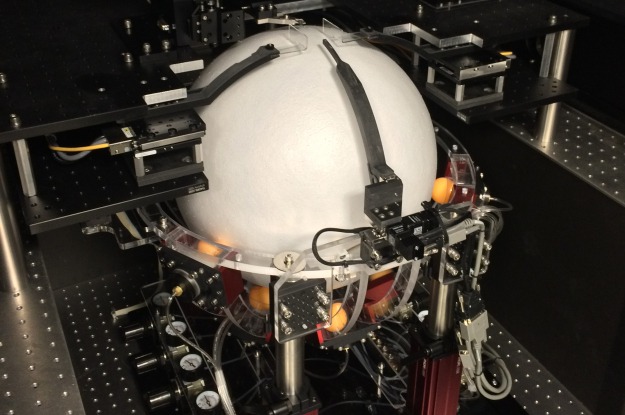
A tactile virtual reality system helps scientists get a feel for a mouse’s view of the world.
A mouse’s whiskers are more than just stiff, overgrown hairs. Exquisitely sensitive, they double as the animal’s eyes when it scurries through inky subterranean passages. Each whisker is controlled by a tiny muscle that allows its owner to palpate objects, relaying information about shape, texture, and location. “One way humans interact with the world is by moving our digits over objects to explore shapes or by moving our eyes over visual scenes,” explains neuroscientist Karel Svoboda. “Mice use their whiskers in the same way.”
When a whisker touches something, it flexes like a spring, putting pressure on the rich supply of nerve endings surrounding the follicle at its base. These nerve cells deliver an array of sensory information to the rodent’s brain, which then decides how the animal should react. Svoboda, a group leader at Janelia Research Campus, is interested in tracking the positions and angles of a mouse’s whiskers as it navigates its surroundings, so as to learn more about the information transmitted from object to whisker to brain.
But tracking whiskers is much easier said than done. Mice can whisk, or move their whiskers in a back-and-forth motion, up to 25 times per second. “To learn how mice use their whiskers, you have to track the tiny hairs with millisecond timescale precision,” says Svoboda. “This involves high-speed videography and a lot of computing.” It also involves either keeping the mouse still or following it closely with a camera as it feels its way along a tunnel. But with a little ingenuity and a lot of trial and error, anything is possible, including building a tactile virtual reality system for mice.
A Virtual Burrow
Svoboda’s postdoc Nick Sofroniew was one of the least likely candidates to take on this virtual reality challenge. When he joined the lab as a graduate student, in 2010, Sofroniew had just completed a master’s degree in mathematics at the University of Cambridge. “A pencil-and-paper–style mathematician, he came to my lab pretty much knowing only the basics in experimental neuroscience,” recalls Svoboda. “So he had to learn all the necessary engineering skills and biology.”
Despite his lack of background knowledge, Sofroniew made the task the focus of his PhD thesis. “I was really attracted to the project’s engineering aspects,” he explains. “I saw it as a rich and interesting opportunity that would let me pick up a lot of skills, and that appealed to me.”
Fortunately, Sofroniew also got a lot of help – from his lab mates; from Janelia’s Instrument Design & Fabrication facility; and, importantly, from Janelia Group Leader Albert Lee and his postdoc Jeremy Cohen.
Lee and Cohen, who share an office space with Svoboda’s team, had just built a visual virtual reality system for rodents. Their rig, a modification of a concept used by other researchers, uses a spherical treadmill – a beach-ball–sized orb of Styrofoam floating on a cushion of air. A mouse is placed on the ball, its head held securely in a tiny metal helmet while it watches a video-game–like maze on a large screen (basically, the rodent equivalent of an IMAX theater). The movements of the ball are connected to the maze software, allowing the diminutive subject to dart through the virtual environment at will.



